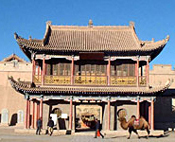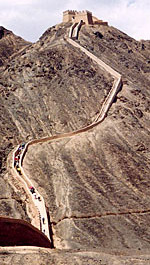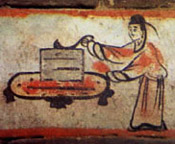|
Jiayuguan
Jiayuguan, a recently developing industrial city of iron-steel production, is located in the middle of Hexi Corridor, Gansu. Historically, it is a small township engaged in local trading, catering to the needs of the military garrisons stationed at the fort; as a Han outpost and in 1372, during the Ming dynasty, a fortress was built to protect the last frontier of the Chinese empire. It is rich in tourist resources and there are many renowned places of historic interest and scenic beauty, namely, the Jiayuguan Pass the other attractions include.
Recommended China Tours Including Jiayuguan:


|
Tourist Highlights
|
| |
 |
Jiayuguan Pass
Located 4 kilometers west of Jiayuguan city on the northwest part of Gansu Province, Jiayuguan pass is the western end of the Great Wall of the Ming Dynasty as well as the most magnificent and best-preserved pass among the over thousand passes along the Ming Great Wall, known as "Impregnable Pass Under Heaven".
The Pass is located at the narrowest point of the western section of the Hexi Corridor, and Jiayuguan often has the meaning of "Nice Valley". It was also a must point of the ancient Silk Road.
The structure was initially built in 1372 during the Ming Dynasty and has a history of more than 600 years. A legend says that when Jiayuguan Pass was to be built, the official in charge of this project asked the designer to count how many bricks and other materials would be used precisely. The designer gave him a specific number. But when the project was finished, one brick was left which was placed on the pass as a symbol of commemoration. |
 |
|
Overhanging Great Wall (Suspension Great Wall )
Eleven kilometers (6.83 miles) to the downtown Jiayuguan City and 6.5 kilometers (4.03 miles) from Jiayuguan Pass, the Overhanging Great Wall was built during the Ming Dynasty (1368-1644). Work began on it in 1539, and was completed in the following year. It was built using layer upon layer of stone and yellow earth. In subsequent years, the wall has dwindled from its original length of 1.5 kilometers (0.93 miles) to its current 750 meters (2, 460 feet).
The Overhanging Wall gets its name because there is a 231 meter long section, with an obliquity of 45 degrees, built onto a 150m high ridge. From a distance, it is said to resemble a dragon about to extend its body towards the ground.
|
 |
|
 |
Weijin Tomb-underground art gallery
In recent years, more than 10 graves dating to Wei and Jin Periods (220-420 AD) have been excavated in the Gobi, some 20 km. east of Jiayuguan. These graves are brick-laid and more than 700 bricks are vividly painted in gay colours.
Renowned as the largest subterranean art gallery in the world, housing a great deal of colorful murals, the gallery has attracted tourists from both home and abroad Most tombs are of families, housing bodies of three or four generations, and now only Grave 6 and Grave 7 are open for tourism. |
Recommended China Tours Including Jiayuguan:


|
|
| Other City |
|
|
 |
| Private China Tours |
|
|
 |
|

